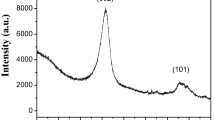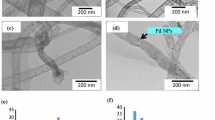Abstract
Aligned nitrogen-doped carbon nanotubes (N-CNTs) containing 6.4–15.7 wt% of nitrogen were synthesized by pyrolysis of 3-ferrocenyl-2-(4-cyanophenyl)acrylonitrile as the catalyst in either acetonitrile or a solution of acetonitrile and ethylbenzoate. For comparison, N-CNTs were synthesized by pyrolysis of 3-ferrocenyl-2-(4-cyanophenyl)acrylonitrile in toluene. The effect of oxygen and the carbon source used during synthesis was investigated. The use of 3-ferrocenyl-2-(4-cyanophenyl)acrylonitrile in acetonitrile as a nitrogen and carbon source selectively yielded mainly N-CNTs, while use of toluene as a carbon source yielded both N-CNTs and carbon spheres. Elemental analysis of the N-CNTs synthesized using both acetonitrile and ethylbenzoate (source of oxygen) indicated that addition of oxygen enhanced the nitrogen content of N-CNTs. This was further supported by results from Raman spectroscopy, X-ray diffraction (XRD), Fourier transform infrared spectroscopy and inverse gas chromatography surface energy analysis. The higher nitrogen-containing N-CNTs were less graphitic and showed a higher base constant (Kb) compared to N-CNTs synthesized without oxygen. Analysis of transmission electron microscopy images showed that the outer diameters of the N-CNTs decreased upon increasing the oxygen composition by mass in the synthesis precursors from 1 to 4 wt% oxygen, the oxygen was derived from ethylbenzoate. In addition, the scanning electron microscopy and XRD revealed that the alignment of N-CNTs increased upon addition of oxygen. Electrical conductivity measurements of N-CNTs showed a negative relationship between the amount of oxygen in the starting materials and the conductivity of N-CNTs.












Similar content being viewed by others
References
Ionescu MI, Zhang Y, Li R, Abou-Rachid H, Sun X (2012) Nitrogen-doping effects on the growth, structure and electrical performance of carbon nanotubes obtained by spray pyrolysis method. Appl Surf Sci 258:4563
Ritter U, Tsierkezos NG, Prylutskyy YI, Matzui LY, Gubanov VO, Bilyi MM, Davydenko MO (2012) Structure–electrical resistivity relationship of N-doped multi-walled carbon nanotubes. J Mater Sci 47:2390. doi:10.1007/s10853-011-6059-6
Liu H, Zhang Y, Li R, Sun X, Abou-Rachid H (2011) Effects of bimetallic catalysts on synthesis of nitrogen-doped carbon nanotubes as nanoscale energetic materials. Particuology 9:465
Bepete G, Tetana ZN, Lindner S, Rümmeli MH, Chiguvare Z, Coville NJ (2013) The use of aliphatic alcohol chain length to control the nitrogen type and content in nitrogen doped carbon nanotubes. Carbon 52:316
Ibrahim EMM, Vyacheslav OK, Leonhardt A, Hampel S, Oswald S, Rümmeli MH, Büchner B (2010) Synthesis, characterization, and electrical properties of nitrogen-doped single-walled carbon nanotubes with different nitrogen content. Diamond Relat Mater 19:1199
Jana D, Sun C-L, Chen L-C, Chen K-H (2013) Effect of chemical doping of boron and nitrogen on the electronic, optical, and electrochemical properties of carbon nanotubes. Prog Mater Sci 58:565
Lai Y-H, Lian H-B, Lee K-Y (2009) Field emission of vertically aligned carbon nanotubes with various content of nitrogen. Diamond Relat Mater 18:544
Ombaka LM, Ndungu P, Nyamori VO (2013) Usage of carbon nanotubes as platinum and nickel catalyst support in dehydrogenation reactions. Catal Today 217:65
Padya B, Kalita D, Jain PK, Padmanabham G, Ravi M, Bhat KS (2013) Nitrogen incorporated highly aligned carbon nanotube arrays thin film grown from single feedstock for field emission. J Nanoelectron Optoe 8:177
Chizari K, Janowska I, Houllé M, Florea I, Ersen O, Romero T, Bernhardt P, Ledoux MJ, Pham-Huu C (2010) Tuning of nitrogen-doped carbon nanotubes as catalyst support for liquid-phase reaction. Appl Catal A 380:72
Liu J, Zhang Y, Ionescu MI, Li R, Sun X (2011) Nitrogen-doped carbon nanotubes with tunable structure and high yield produced by ultrasonic spray pyrolysis. Appl Surf Sci 257:7837
Nxumalo EN, Chabalala VP, Nyamori VO, Witcomb MJ, Coville NJ (2010) Influence of methylimidazole isomers on ferrocene-catalysed nitrogen doped carbon nanotube synthesis. J Organomet Chem 695:1451
Thurakitseree T, Kramberger C, Zhao P, Aikawa S, Harish S, Chiashi S, Einarsson E, Maruyama S (2012) Diameter-controlled and nitrogen-doped vertically aligned single-walled carbon nanotubes. Carbon 50:2635
Imrie C, Kleyi P, Nyamori VO, Gerber TIA, Levendis DC, Look J (2007) Further solvent-free reactions of ferrocenylaldehydes: synthesis of 1,10-ferrocenyldiimines and ferrocenylacrylonitriles. J Organomet Chem 692:3443
Oosthuizen RS, Nyamori VO (2012) Heteroatom-containing ferrocene derivatives as catalysts for MWCNTs and other shaped carbon nanomaterials. Appl Organomet Chem 26:536
Nyamori VO, Nxumalo EN, Coville NJ (2009) The effect of arylferrocene ring substituents on the synthesis of multi-walled carbon nanotubes. J Organomet Chem 694:2222
Trancik JE, Barton SC, Hone J (2008) Transparent and catalytic carbon nanotube films. J Nano Lett 8:982
Chen L, Xia K, Huang L, Li L, Pei L, Fei S (2013) Facile synthesis and hydrogen storage application of nitrogen-doped carbon nanotubes with bamboolike structure. Int J Hydrogen Energy 38:3297
Kovalevski VV, Safronov AN (1998) Pyrolysis of hollow carbons on melted catalyst. Carbon 36:963
Zhang C, Lv M, Wang X, Li J, Yang X, Yang J, Hu H (2013) Controllable synthesis and formation mechanism of carbon micro/nano-structural materials. Chem Phys Lett 586:121
Lifshitz A, Tamburu C (1999) Thermal decomposition of acetonitrile. Kinetic modeling. Int J Chem Kinet 30:341
Shaikjee A, Coville NJ (2012) The role of the hydrocarbon source on the growth of carbon materials. Carbon 50:3376
Derudi M, Polino D, Cavallotti C (2011) Toluene and benzyl decomposition mechanisms: elementary reactions and kinetic simulations. Phys Chem Chem Phys 13:21308
Koós AA, Dowling M, Jurkschat K, Crossley A, Grobert N (2009) Effect of the experimental parameters on the structure of nitrogen-doped carbon nanotubes produced by aerosol chemical vapor deposition. Carbon 47:30
Liu S, Zhang Y, Lin Y, Zhao Z, Li Q (2014) Tailoring the structure and nitrogen content of nitrogen-doped carbon nanotubes by water-assisted growth. Carbon 69:247
Rümmeli MH, Borowiak-Palen E, Gemming T, Pichler T, Knupfer M, Kalbác M, Dunsch L, Jost O, Silva SRP, Pompe W, Buchner B (2005) Novel catalysts, room temperature, and the importance of oxygen for the synthesis of single-walled carbon nanotubes. Nano Lett 5:1209
Sumpter BG, Meunier V, Romo-Herrera JM, Cruz-Silva E, Cullen DA, Terrones H, Smith DJ, Terrones M (2007) Nitrogen-mediated carbon nanotube growth: diameter reduction, metallicity, bundle dispersability, and bamboo-like structure formation. ACS Nano 1:369
Jourdain V, Bichara C (2013) Current understanding of the growth of carbon nanotubes in catalytic chemical vapour deposition. Carbon 58:2
Ci L, Vajtai R, Ajayan PM (2007) Vertically aligned large-diameter double-walled carbon nanotube arrays having ultralow density. J Phys Chem C 111:9077
Belin T, Epron F (2005) Characterization Methods of carbon nanotubes: a review. Mater Sci Eng B 119:105
Lambin P, Loiseau A, Culot C, Biro L (2002) Structure of carbon nanotubes probed by local and global probes. Carbon 40:1635
Chiang YC, Lin W-H, Chang Y-C (2011) The influence of treatment duration on multi-walled carbon nanotubes functionalized by H2SO4/HNO3 oxidation. Appl Surf Sci 257:2401
Khani H, Moradi O (2013) Influence of surface oxidation on the morphological and crystallographic structure of multi-walled carbon nanotubes via different oxidants. J Nanostructure Chem 3:73
Paradise M, Goswami T (2007) Carbon nanotubes–production and industrial applications. Mater Des 28:1477
Singh DK, Iyer PK, Giri PK (2010) Diameter dependence of interwall separation and strain in multiwalled carbon nanotubes probed by X-ray diffraction and Raman scattering studies. Diamond Relat Mater 19:1281
Emmenegger C, Bonard J-M, Mauron P, Sudan P, Lepora A, Grobety B, Züttel A, Schlapbach L (2003) Synthesis of carbon nanotubes over Fe catalyst on aluminium and suggested growth mechanism. Carbon 41:539
Wirth CT, Bayer BC, Gamalski AD, Esconjauregui S, Weatherup RS, Ducati C, Baehtz C, Robertson J, Hofmann S (2012) The phase of iron catalyst nanoparticles during carbon nanotube growth. Chem Mater 24:4633
Hiura H, Ebbesen T, Tanigaki K, Takahashi H (1993) Raman studies of carbon nanotubes. Chem Phys Lett 202:509
Wepasnick KA, Smith BA, Bitter JL, Fairbrother DH (2010) Chemical and structural characterization of carbon nanotube surfaces. Anal Bioanal Chem 396:1003
Liu Y, Pan C, Wang J (2004) Raman spectra of carbon nanotubes and nanofibers prepared by ethanol flames. J Mater Sci 39:1091. doi:10.1023/B:JMSC.0000012952.20840.09
Sharifi T, Nitze F, Barzegar HR, Tai C-W, Mazurkiewicz M, Malolepszy A, Stobinski L, Wågberg T (2012) Nitrogen doped multi walled carbon nanotubes produced by CVD-correlating XPS and Raman spectroscopy for the study of nitrogen inclusion. Carbon 50:3535
Hussain S, Amade R, Jover E, Bertran E (2013) Nitrogen plasma functionalization of carbon nanotubes for supercapacitor applications. J Mater Sci 48:7620. doi:10.1007/s10853-013-7579-z
Jorio A, Pimenta MA, Filho AGS, Saito R, Dresselhaus G, Dresselhaus MS (2003) Characterizing carbon nanotube samples with resonance Raman scattering. New J Phys 5(139):131
Saito R, Jorio A, Hafner JH, Lieber CM, Hunter M, McClure T, Dresselhaus G, Dresselhaus MS (2001) Chirality-dependent G-band Raman intensity of carbon nanotubes. Phys Rev B 64:085312
Kim U-J, Furtado CA, Liu X, Chen G, Eklund PC (2005) Raman and IR spectroscopy of chemically processed single-walled carbon nanotubes. J Am Chem Soc 127:15437
Chizari K, Vena A, Laurentius L, Sundararaj U (2014) The effect of temperature on the morphology and chemical surface properties of nitrogen-doped carbon nanotubes. Carbon 68:369
Santangelo S, Lanza M, Milone C (2013) Evaluation of the overall crystalline quality of amorphous carbon containing multiwalled nanotubes. J Phys Chem C 117:4815
Cao A, Xu C, Liang J, Wu D, Wei B (2001) X-ray diffraction characterization on the alignment degree of carbon nanotubes. Chem Phys Lett 344:13
Zhang G, Mann D, Zhang L, Javey A, Li Y, Enilmez EY, Wang Q, McVittie JP, Nishi Y, Gibbons J, Dai H (2005) Ultra-high-yield growth of vertical single-walled carbon nanotubes: hidden roles of hydrogen and oxygen. PNAS 102:16141
Dorris GM, Gray DG (1980) Adsorption of normal-alkanes at zero surface coverage on cellulose paper and wood fibers. J Colloid Interface Sci 77:353
Menzel R, Lee A, Bismarck A, Shaffer MSP (2009) Inverse gas chromatography of as-received and modified carbon nanotubes. Langmuir 25:8340
Khoo J, Burnett D, Menzel R, MSP Shaffer (2012) Surface energetic heterogeneity of carbon-based nanomaterials. www.TheSorptionSolution.com. Accesed 21 June 2012
Vanyoreka L, Meszarosa R, Barany S (2014) Surface and electrosurface characterization of surface-oxidizedmulti-walled N-doped carbon nanotubes. Colloids Surf A 448:140
Misra A, Tyagi PK, Singh MK, Misra DS (2006) FTIR studies of nitrogen doped carbon nanotubes. Diamond Relat Mater 15:385
Maiyalagan T, Viswanathan B (2005) Template synthesis and characterization of well-aligned nitrogen containing carbon nanotubes. Mater Chem Phys 93:291
Bandosz TJ (2009) Surface chemistry of carbon materials. In: Serp P, Fiueiredo JL (eds) Carbon materials for catalysis. Wiley, Hoboken, p 63
Jianwei Z, Dazhi J, Hua-Xin P (2014) A pressurized filtration technique for fabricating carbon nanotube buckypaper: structure, mechanical and conductive properties. Microporous Mesoporous Mater 184:127
Jianwei Z, Dazhi J, Hua-Xin P, Faxiang Q (2013) Enhanced mechanical and electrical properties of carbon nanotube buckypaper by in situ cross-linking. Carbon 63:125
Latil S, Roche S, Mayou D, Charlier JC (2004) Mesoscopic transport in chemically doped carbon nanotubes. Phys Rev Lett 92(1):256805
Acknowledgements
The National Research Foundation (NRF) and University of KwaZulu-Natal (UKZN) financed this research. We are grateful to Prof B. S. Martincigh, Dr. N. Nombona and Dr. R. S. Mwakubambanya, for assisting in proof-reading the manuscript and their critical comments of the manuscript.
Author information
Authors and Affiliations
Corresponding author
Electronic supplementary material
Below is the link to the electronic supplementary material.
Rights and permissions
About this article
Cite this article
Ombaka, L.M., Ndungu, P.G. & Nyamori, V.O. Tuning the nitrogen content and surface properties of nitrogen-doped carbon nanotubes synthesized using a nitrogen-containing ferrocenyl derivative and ethylbenzoate. J Mater Sci 50, 1187–1200 (2015). https://doi.org/10.1007/s10853-014-8675-4
Received:
Accepted:
Published:
Issue Date:
DOI: https://doi.org/10.1007/s10853-014-8675-4




